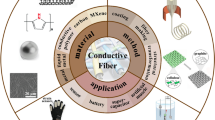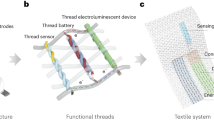Abstract
Fiber-based wearable electronic circuits and systems are a very promising next-generation technology for human-computer interaction, long-term health monitoring, virtual reality, and other fields. The advancement of nanotechnology has made it feasible to build electronic devices directly on the surface or inside of single fibers, which have typical thickness of several to tens of microns. However, imparting electronic functions to porous, highly deformable, and three-dimensional fiber assemblies and maintaining them during wear represent great challenges from both views of fundamental understanding and practical implementation. This chapter primarily focuses on the elementary electronic devices of fiber-type transistor, as well as fiber-based transistor circuits. As an important tie between the bottom physical layer to the top system layer, the electronic interfaces of fiber-based elements and arrays have been also considered. Lastly, two prototypes of fiber-based wearable system, the intelligent footwear system and smart cushion cover, are confronted, including the scheme plan, package, testing, and evaluation. Limitations of current materials, fabrication techniques, circuits, and systems concerning manufacturability and performance as well as scientific understanding that must be improved prior to their wide adoption have been also discussed.
Similar content being viewed by others
References
Tao XM (ed) (2005) Wearable electronics and photonics. Woodhead Publishing, Boca Raton
Zeng W, Shu L, Li Q, Chen S, Wang F, Tao XM (2014) Fiber-based wearable electronics: a review of materials, fabrication, devices, applications. Adv Mater 26:5310–5336
Reddy AM, ImranáJafri R (2011) Carbon nanocoils for multi-functional energy applications. J Mater Chem 21(40):16103–16107
Windmiller JR, Wang J (2013) Wearable electrochemical sensors and biosensors: a review. Electroanalysis 25(1):29–46
Lee JB, Subramanian V (2005) Weave patterned organic transistors on fiber for e-textiles. IEEE Trans Electron Devices 52(2):269–275
De Rossi D (2007) Electronic textiles: a logical step. Nat Mater 6(5):328–329
Hamedi M, Herlogsson L, Crispin X, Marcilla R, Berggren M, Inganäs O (2009) Fiber-embedded electrolyte-gated field-effect transistors for e-textiles. Adv Mater 21(5):573–577
Tao X, Koncar V, Dufour C (2011) Geometry pattern for the wire organic electrochemical textile transistor. J Electrochem Soc 158(5):H572–H577
Maccioni M, Orgiu E, Cosseddu P, Locci S, Bonfiglio A (2006) Towards the textile transistor: assembly and characterization of an organic field effect transistor with a cylindrical geometry. Appl Phys Lett 89(14):143515
Wang S, Kappl M, Liebewirth I, Müller M, Kirchhoff K, Pisula W, Müllen K (2012) Organic field-effect transistors based on highly ordered single polymer fibers. Adv Mater 24(3):417–420
Hamedi M, Forchheimer R, Inganäs O (2007) Towards woven logic from organic electronic fibres. Nat Mater 6(5):357–362
Khodagholy D, Rivnay J, Sessolo M, Gurfinkel M, Leleux P, Jimison LH, Malliaras GG (2013) High transconductance organic electrochemical transistors. Nat Commun 4:2133
Tarabella G, Villani M, Calestani D, Mosca R, Iannotta S, Zappettini A, Coppedè N (2012) A single cotton fiber organic electrochemical transistor for liquid electrolyte saline sensing. J Mater Chem 22(45):23830–23834
Zou D, Lv Z, Cai X, Hou S (2012) Macro/microfiber-shaped electronic devices. Nano Energy 1(2):273–281
Jalili R, Razal JM, Innis PC, Wallace GG (2011) One-step wet-spinning process of poly (3, 4-ethylenedioxythiophene): poly (styrenesulfonate) fibers and the origin of higher electrical conductivity. Adv Funct Mater 21(17):3363–3370
Xu Z, Liu Z, Sun H, Gao C (2013) Highly electrically conductive Ag-doped graphene fibers as stretchable conductors. Adv Mater 25(23):3249–3253
Sekitani T, Takamiya M, Noguchi Y, Nakano S, Kato Y, Sakurai T, Someya T (2007) A large-area wireless power-transmission sheet using printed organic transistors and plastic MEMS switches. Nat Mater 6:413–417
Sahai Saxena R, Bhan R, Kaur Saini N, Muralidharan R (2011) Virtual ground technique for crosstalk suppression in networked resistive sensors. IEEE Sensors J 11(2):432–433
Lorussi F, Rocchia W, Scilingo EP, Tognetti A, De Rossi D (2004) Wearable, redundant fabric-based sensor arrays for reconstruction of body segment posture. IEEE Sensors J 4(6):807–818
Liu H, Zhang YF, Liu YW, Jin MH (2010) Measurement errors in the scanning of resistive sensor arrays. Sensors Actuators A Phys 163(1):198–204
Alirezaei H, Nagakubo A, Kuniyoshi Y (2009) A tactile distribution sensor which enables stable measurement under high and dynamic stretch. In: IEEE symposium on 3D user interfaces 3DUI 2009, pp 87–93
Shu L, Tao XM, Feng DD (2014) A new approach for readout of resistive sensor arrays for wearable electronic applications. IEEE sensors J 15:442–452
Bamberg S, Benbasat AY, Scarborough DM, Krebs DE, Paradiso JA (2008) Gait analysis using a shoe-integrated wireless sensor system. IEEE Trans Inf Technol Biomed 12(4):413–423
Pappas IPI, Keller T, Mangold S, Popovic MR, Dietz V, Morari M (2004) A reliable gyroscope-based gait-phase detection sensor embedded in a shoe insole. IEEE Sensors J 4(2):268–274
Saponas T, Lester J, Hartung C, Kohno T (2006) Devices that tell on you: the nike + ipod sport kit. Department of Computer Science and Engineering, University of Washington. Technical report [Online]. Available: http://www.cs.washington.edu/research/systems/privacy.html. Accessed Nov 2006
Eskofier B, Oleson M, DiBenedetto C, Hornegger J (2009) Embedded surface classification in digital sports. Pattern Recogn Lett 30:1448–1456
Shu L, Hua T, Wang Y, Li Q, Feng DD, Tao XM (2010) In-shoe plantar pressure measurement and analysis system based on fabric pressure sensing array. IEEE Trans Inf Technol Biomed 14(3):767–775
Wang Y, Hua T, Zhu B, Li Q, Yi W, Tao X (2011) Novel fabric pressure sensors: design, fabrication, and characterization. Smart Mater Struct 20(6):065015
Shabshin N, Zoizner G, Herman A, Ougortsin V, Gefen A (2010) Use of weight-bearing MRI for evaluating wheelchair cushions based on internal soft-tissue deformations under ischial tuberosities. J Rehabil Res Dev 47(1):31–42
Hagisawa S, Ferguson-Pell M (2008) Evidence supporting the use of two-hourly turning for pressure ulcer prevention. J Tissue Viability 17(3):76–81
Xu W, Huang MC, Amini N, He L, Sarrafzadeh M (2013) eCushion: a textile pressure sensor array design and calibration for sitting posture analysis. IEEE Sensors J 13(10):3926–3934
Lorussi F, Scilingo EP, Tesconi A, Tognetti A, De Rossi D (2003) Wearable sensing garment for posture detection, rehabilitation and tele-medicine. In: Fourth international IEEE EMBS special topic conference on information technology applications in biomedicine, Birmingham, pp 287–290
Data Acquisition Hardware, Tekscan Inc., Boston, MA, US [Online]. Available: http://www.tekscan.com/sensor-technology
Wu Y (2010) Development of an approach for interface pressure measurement and analysis for study of sitting. M. Eng. dissertation, Department of Mechanical Engineering, National University of Singapore, Singapore
Pang C, Lee GY, Kim TI, Kim SM, Kim HN, Ahn SH et al (2012) A flexible and highly sensitive strain-gauge sensor using reversible interlocking of nanofibres. Nat Mater 11:795–801
Mattmann C, Clemens F, Troster G (2008) Sensor for measuring strain in textile. Sensors 8:3719–3732
Kamiya K, Kudo M, Nonaka H, Toyama J (2008) Sitting posture analysis by pressure sensors. In: Nineteenth international conference on pattern recognition (ICPR), pp 1–4
Tasker LH, Shapcott NG, Watkins AJ, Holland PM (2014) The effect of seat shape on the risk of pressure ulcers using discomfort and interface pressure measurements. Prosthet Orthot Int 38(1):46–53
Author information
Authors and Affiliations
Corresponding author
Editor information
Editors and Affiliations
Rights and permissions
Copyright information
© 2015 Springer Science+Business Media Singapore
About this entry
Cite this entry
Lin, S. (2015). Fiber-Based Wearable Electronic Circuits and Systems. In: Tao, X. (eds) Handbook of Smart Textiles. Springer, Singapore. https://doi.org/10.1007/978-981-4451-68-0_24-1
Download citation
DOI: https://doi.org/10.1007/978-981-4451-68-0_24-1
Received:
Accepted:
Published:
Publisher Name: Springer, Singapore
Online ISBN: 978-981-4451-68-0
eBook Packages: Springer Reference Chemistry and Mat. ScienceReference Module Physical and Materials ScienceReference Module Chemistry, Materials and Physics




